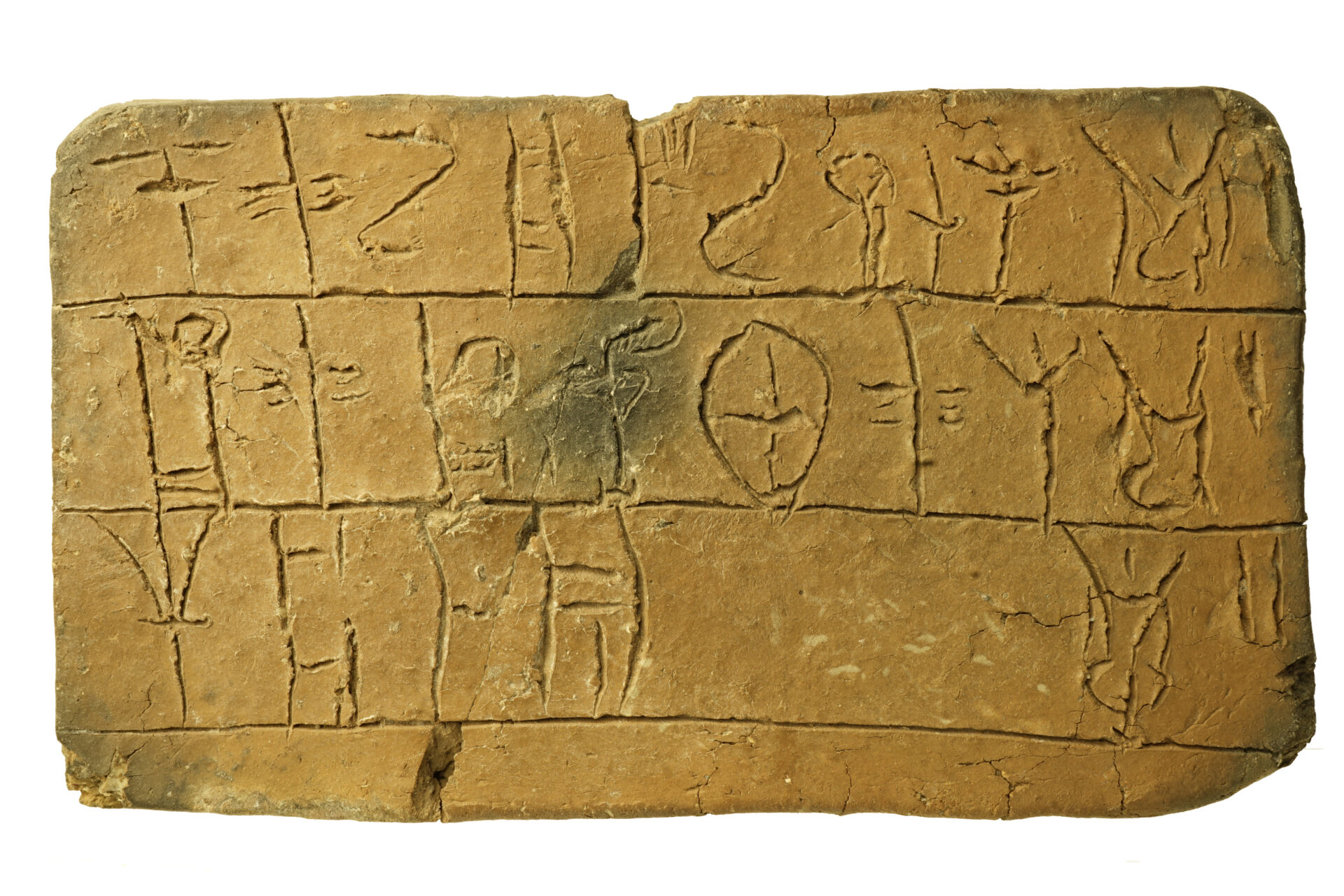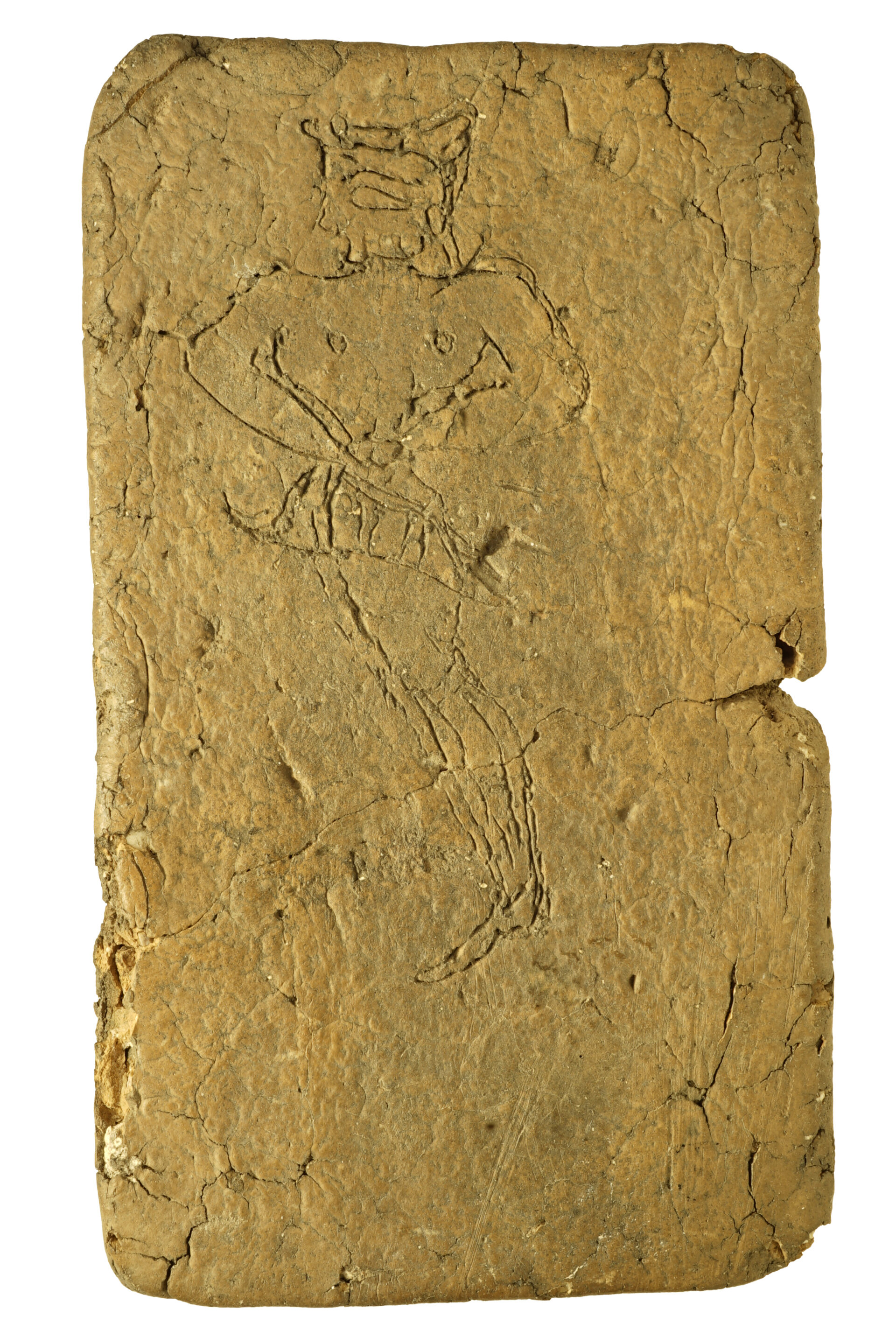Exhibit of the month
A versatile Mycenaean scribe
Linear B tablet
National Archaeological Museum
Prehistoric Collection, Inv.no. Π7671 (13098) (MY Oe 106).
Provenance: Mycenae. “House of the Oil Merchant”.
Dimensions: Height: 5,2 cm.,Width: 9,4 cm.,Thickness: 1,3 cm.
Date: 13th c. B.C.
Display: Prehistoric Collection, Mycenaean Gallery 4, Case Μ 24.
A young and robust Mycenaean wearing only a short kilt decorated with fringes looks like he is dancing on his toes with his hands at his waist holding a kind of knife. Is this man perhaps featuring in a work of an artist who depicted him on a pictorial style vase [1], a palace wall-painting, a gold signet ring [2] or some other decorated object? Surprisingly not. It is a drawing incised on the verso of a small Linear B tablet from the “House of the Oil Merchant”[3] at Mycenae. Though it is not the only such sketch found on a tablet, it is the only one that depicts a human figure.
Linear B tablets were accounting records controlled by the Mycenaean palaces. Strict bureaucracy left no room for flexibility to scribes. Accuracy and attention were required. A scribe could correct a mistake by erasure or use other faces of a tablet if necessary. The scribe of this tablet, however, went through with something new. Was he perhaps influenced by the wall decoration of his workplace? Did he take a break from the boring work? Did the record itself lead him to the sketch?
The tablet is one of the 27 set of tablets found together in the “House of the Oil Merchant”, where it is proved that wool was processed. The recto of the tablet, by Hand 51[4], records a supply of wool[5] followed by an adjective which may be interpreted either as “dyed” or “spun”[6]. Is it then maybe possible that the scribe designed the young man to represent on his kilt the decorative elements for which the small quantities of wool of his record were intended? “Illustration” would not be something he was asked to do, and can be explained as a personal need of a repressed scribe to visualize[7] the record he had to deliver. Nevertheless, he managed to offer artistic value to a bureaucratic object, such as a tablet.
Dr. Katerina Voutsa
[1] Pictorial style is a kind of Mycenaean pottery decoration including representations of stylized motifs and scenes. Male figures are common on pictorial style vessels.
[2] Gold signet rings are treasured belongings whose decoration, often including scenes with human figures, is of high artistic quality.
[3] Part of a building complex outside the fortification wall of the Mycenae Acropolis which combines residential features and craft activities.
[4] 6 more tablets from Mycenae, all records of wool, are attributed to Hand 51. The 27 tablets of the Oe Class are the work of 5 different Hands.
[5] In Linear B writing system the logogram 𐂝 (*145- LANA) is used to record wool.
[6] ko-ro-to /khrōston/ or /klōston/. The adjective may be used to describe either the color or the kind of textile or even a woolen decorative element of the fabric.
[7] The possibility that the content of the record itself could lead a scribe to its visualization is reinforced by tablet An 724 from Pylos which records rowers on the recto while on its verso there is the sketch of s ship.
BIBLIOGRAPHY
Bennett, E.L., Jr. (ed)., 1958. The Mycenae Tablets II. With an introduction of A.J.B. Wace and E. B. Wace. Translation and Commentary by J. Chadwick, TAPS 48, Part 1, Philadelpheia.
Palaima, Th.G., 1992. “Mycenaean Scribal Aesthetics” in R. Laffineur and J.L. Crowley (eds) ΕΙΚΩΝ1992. Aegean Bronze Age Iconography: Shaping a Methodology. 4th International Aegean Conference, University of Tasmania, Hobart, 6-9 April 1992. Aegaeum 8 , Liège, 63-75.
Tournavitou, Iph.,1995. The ‘Ivory Houses’ at Mycenae. London, BSA Supplementary 24.
Tournavitou, Iph., E. Andersson Strand, M.-L. Nosch, and J. Cutler., 2015. “Textile production at Mycenae, mainland Greece”, in E. Andersson Strand and M.-L. Nosch (eds.) Tools, Textiles and Contexts: Investigating Textile Production in the Aegean and Eastern Mediterranean Bronze Age, Ancient Textiles Series 21, Oxford and Philadelphia, 253-265.
Varias García, C., 2008 “Destiñendo la lana micénica: ka-sa-to y a-ko-ro-ta en las tablillas MY Oe 113, Oe 115 y Go 610”, Faventia 30 (1-2), 53-67.



